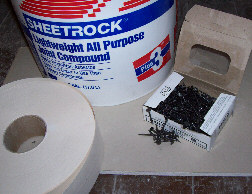
Drywall How To Manual
Drywall Home | History | Tools | Preparation | Materials | Wallboard InstallationMudding | Finishing Up | Patching | Outlet Install
|
Drywall MaterialsSelecting drywall might seem as simple as going to the lumber yard with a pickup and telling the owner to load it up with x number of sheets. But it is not so simple. First you must determine what the wall (or ceiling) in question is to be used for. If it is a standard interior wall or even most exterior walls, then 1/2-in thick drywall will do. If the wall is next to a fire hazard (sometimes called an attached garage), you will want (or required by the local inspector) to go with 5/8-inch drywall. This acts as an aid to keep fire from spreading quickly, in the event of such a calamity. Wallboard usually comes in 4X8-foot sheets, but can come in 4X12 sheets as well. It is best stored lying flat on a dry even surface.
When a wall is to be positioned next to a sink, or might take a few splashes, as near a toilet, there is a special type of drywall that is water resistant. It is usually colored green and it is called by most builders, surprise, "green board". The paper is resistant to water and it keeps the gypsum sandwiched between the layers of paper from disintegrating. Yet, this type of wallboard has been found by some builders to be insufficient for use in showers and tubs, where water can leak through the grout and be trapped next to the wallboard for long periods. For these cases look for gypsum board that is 100% waterproof, or you might even consider a cement product often called "cement drywall" or more commercially, "Duroc" and "Hardibacker". All drywall is fireproof to a degree. However, various local codes may require greater fireproofing as between a house and attached garage, or between apartments. Multiple layers, thicker drywall, or special types of fire-resistant drywall called type x or type c may be used. When determining the amount of wallboard necessary to do the job, factor in the fact that, unless your room is perfectly square, without entrances, exits, windows and closets, as well as outlets and lights, and that these dimensions are evenly divisible by 48 inches, you will need to cut the drywall. This cutting is going to lead to wastage as well as an occasional error. Thus the square foot of wallboard needed, will be much closer to the length times width of the wall than it will be by the actual space covered. Don't count on being able to efficiently use scraps unless, you have some very big openings in the wall. To be safe and avoid multiple runs to the lumber yard, it is best to figure your room dimensions, calculate the square footage of surface area without taking into account the openings and then add an extra sheet just for slop. To hang the drywall will require nails or screws. There are standard drywall nails and screws that are made to specific lengths. If you are putting up drywall in places that may get wet, be certain to get screws or fasteners that will not deteriorate in the presence of water. The number of fasteners will of course vary by the amount of drywall to be hung. Generally, you can figure approximately one pound of nails for every five 4X8 sheets. Drywall corners will be necessary for every protruding angle. Corners are a very light angled metal that forms an "L" shape. You will need approximately the same number of linear feet of this product as you have linear feet of protruding corners. A drywall job is not complete without the plaster. This, you can get in many different forms. You can get it in a bag, where it must be mixed. You can also get it premixed, which is really the way that a beginner should go. The plaster is inexpensive in either form and a 5 gallon bucket will cover a good sized area, even used liberally. The type of plaster, should also match the type of drywall used. Regular plaster will work in most circumstances, and the average do-it-yourselfer will not want a plaster that is too quick-drying. How much of this you will need is largely dependent on your experience level and the number of seams. An efficient drywaller needs about 5 gallons for every 1000 square feet of drywall. Drywall tape is also a necessity. This is not a sticky substance. It is really just a roll of thick paper. It is used to link the wallboards together and allow a smooth coat to be smeared on over the top. These strips are about two inches wide and are either made of paper or a plastic mesh. The plastic is stronger, but harder to work with. A 250 foot roll will probably go for about 16 sheets of drywall, but it will definitely vary depending on the number of openings and seams. |
Mudding | Finishing Up | Patching | Outlet Install
Contact Us | Privacy Statement | Laptop Repairs
